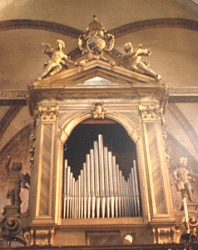  Italy
|
|
In the history of music in western Europe, perhaps no country has provided more lasting influence than has Italy. Largely because of its prominence in the early sixteenth century, musicians of all countries and native languages learn the meaning of "allegro," "andante," and countless other Italian words as a part of their earliest training. Stylistic elements such as imitative counterpoint were first clarified in Italian music, and we generally credit Italians with the emergence of both Renaissance and Baroque musical styles. In light of this cultural and linguistic dependence on Italian music, it might seem curious that organists in the United States are often limited in their knowledge of Italian organs and organ music. This lack of familiarity with Italian organ music is caused by two reasons:
Nevertheless, organs and organ literature owe much to developments that appeared first in Italy. In particular, stop mechanisms appear to have an Italian origin, and the music of Girolamo Frescobaldi is arguably the source of many expressive characteristics in seventeenth-century North German literature. The pages of this tutorial that treat the subject of Italian organs are fewer in number than those that describe the organ in Germany, for example, but they are no less important. The "Italy" menu includes both the general page on the organ in the fifteenth century and the introduction to the organ in the sixteenth century, because they contain important background information that will make later pages clearer. It then lists all pages on Italian organs in chronological order beginning with the sixteenth century. Finally, it includes pages on specific instruments and builders between the relevant pages about the organ in different centuries. For example, you will find the page on Antegnati between the sixteenth-century page and the seventeenth-century page, because the family includes many important builders between 1500 and 1600. Please remember that if you are reading this with a browser that can read frames, you can resize any frame to give you a clearer view of its contents. © 1999 James H. Cook |